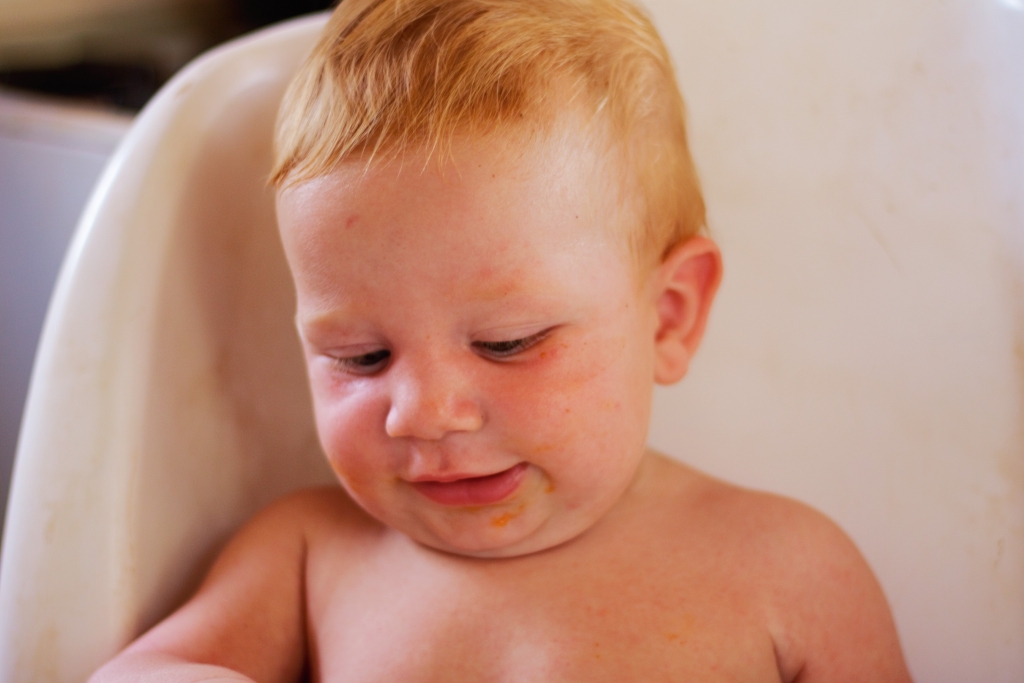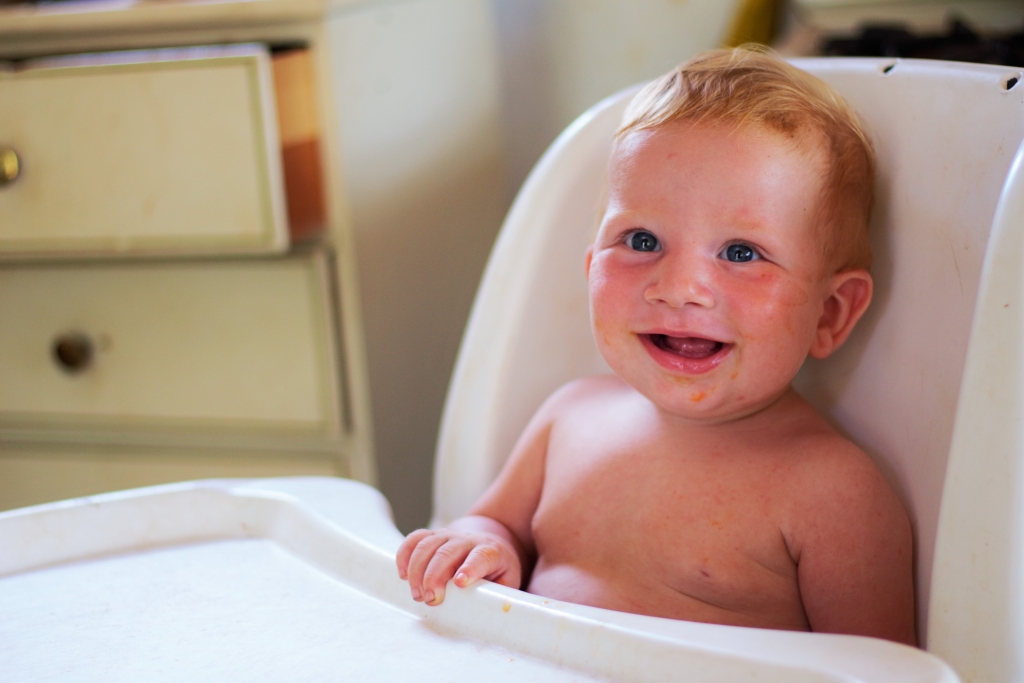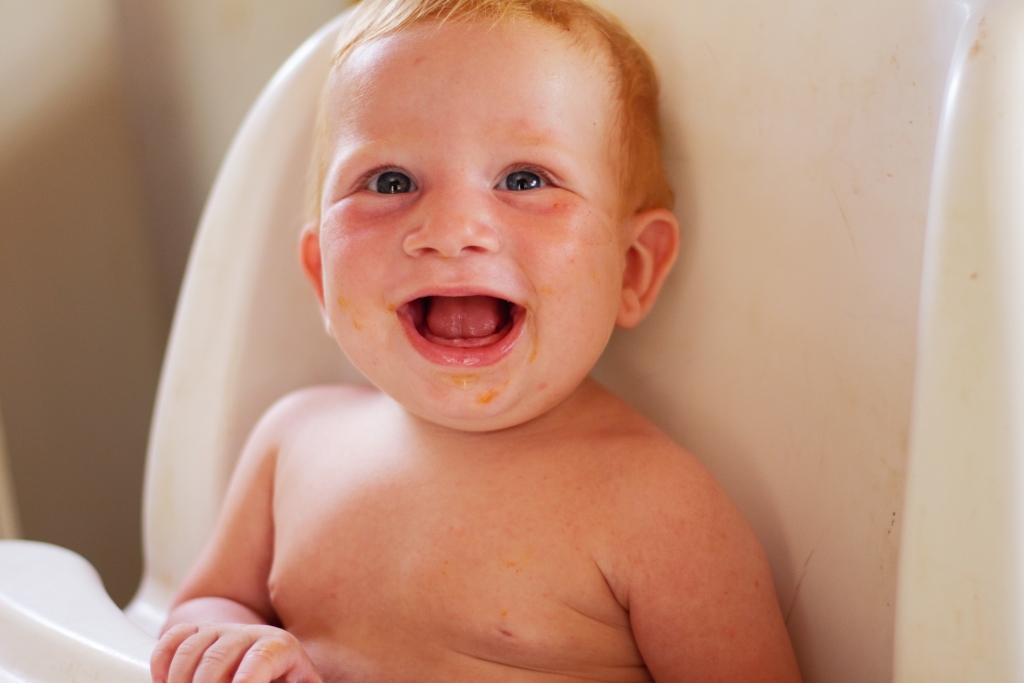The Five Elements of Nourishing Babies

I distinctly remember a battle over a spoonful of cauliflower that went down nearly ten years ago. Elijah had just started solid foods and I had no clue what I should feed him except that I should be making it myself and there should be vegetables. It was not pretty, y’all.
Fast forward to our second son, Abram, who became our first real food baby. When he began eating solids, I would place mashed up stuff in separate little piles all over his tray. There was usually a meat or protein, a mashed vegetable, and sometimes a starch like potato or rice. All of them contained lots of fat mixed in and he invariably reached for the animal products first.
My Two Favorite Resources
Before I get to the five things I consider when feeding our babies, I’d like to share two things that have been by my side through the last four of our newly eating little ones. The first is this book and the invaluable information I’ve gleaned from it. The second is a simple device my Mother-In-Law gave me way back when I first became a Mama.
I used to whiz up ice cube trays full of baby food in my food processor. After a few babies and a little less time on my hands (and now no freezer or food processor), this food mill has been my absolute favorite. I simply take the elements of the family meal that the baby can eat, add a bit of extra fat, milk, or water, and blend it up. So simple.

The Five Nutritional Needs of Little Ones
In feeding babies for the first couple of years I like to put an emphasis on the following:
Fat. This can not be over-emphasized for little ones, in my opinion. The largest portion of calories in breastmilk comes from fat. I think we can take this God-given food and have it not be much of a stretch to say that a good 50% of a baby’s calories could come from fat. So I add grass-fed butter, coconut oil, and olive oil to pretty much everything I give them. And avocado is probably my favorite baby convenience food.
Minerals. I personally think minerals are an under-emphasized component of a traditional food diet. I try to emphasize mineral-rich foods for our children but also for us. After having five babies in ten years, I know my own mineral stores are greatly depleted, despite our best efforts to keep them tanked up. So it is important to always be adding to the minerals tank. At first I like to emphasize cultured dairy, bone broth, mineral-rich animal foods like egg yolks, meat, and canned salmon. After they are a little older I like to add in leafy greens and legumes.
Carbohydrates. The other main constituent in breastmilk is carbohydrates. At first I like to emphasize simple starches like cooked root vegetables + fat, white rice + fat, potatoes + fat. I also do small quantities of soft fruits like bananas and applesauce, but try not to give too many sweet foods. After they get a bit older I add in fermented oats and other fermented grains… with, you guessed it, fat.
Protein. While I do like to give babies dark poultry meat, red meats, and wild canned salmon, I try to do it in balance with the fat and carbohydrates. And I generally emphasize fresh and cultured dairy over other protein sources, in terms of calories.
Ferments. I think it’s important to introduce children to fermented foods early. I feel the same way about bitter foods like greens. Both Annie and Ruthie got kraut and kraut juice young and Joshua takes kraut brine off of a spoon from time to time. Abram was our first baby to get kombucha at one year of age. All of the children have gotten homemade yogurt and kefir under one year of age and all of them rave about the super tangy kefir and yogurt I bring to the table and serve with no added sweetener. Abram is also well-known for complimenting my seemingly failed loaves of over-fermented sourdough by saying “You know what I like about this bread? It’s got a nice tang!”.

People often tell me that we have such good eaters but I really don’t think that our children are any different than any other children. The first time someone offered them candy I watched in horror as they tried to shovel it in as fast as they could before I could stop them. And we’ve certainly had health issues come up here and there. We also have a pretty picky eater (cough, Annabelle, cough). Oh, and I totally bought the boys ice cream cones the other day when it was 100 degrees and we went to town.
I think I had to get that off my chest.
By in large, though, I am grateful for how easy it is to feed this crew and I really think it comes down to some of the same principles that I strongly believe in about parenting in general. Lead by example. Tell them why. Put what is right and good in front them. And sometimes, what you don’t give them is just as important as what you do.

I entirely agree with you my eldest is 13 and we tried her diligently at 6mths with rice cereal ( organic and made with my breast milk ) ha! Then promptly gave up and left her alone with solids until she actually showed interest at 8mths and we did baby led weaning, no purses or mush just good solid foods with no additives. Second baby was an eater on his own at 6mths ( he does everything first ) again baby led weaning mainly veggies on his tray with good fats. Last baby was the slowest to,do everything and didn’t actually eat solids until he was 1yo! I’m grateful they were all breastfed, solely for that period so I had no worries about their intake. Not one has ever consumed ready made baby food from a jar or packet
my eldest is 13 and we tried her diligently at 6mths with rice cereal ( organic and made with my breast milk ) ha! Then promptly gave up and left her alone with solids until she actually showed interest at 8mths and we did baby led weaning, no purses or mush just good solid foods with no additives. Second baby was an eater on his own at 6mths ( he does everything first ) again baby led weaning mainly veggies on his tray with good fats. Last baby was the slowest to,do everything and didn’t actually eat solids until he was 1yo! I’m grateful they were all breastfed, solely for that period so I had no worries about their intake. Not one has ever consumed ready made baby food from a jar or packet  they are all great eaters too! Even with other crushing sensory issues. Food has never been one.
they are all great eaters too! Even with other crushing sensory issues. Food has never been one.
Linda – Wow, that sounds great and every baby is so different, aren’t they? I didn’t mean to imply that I’ve never given the children pureed baby foods – I certainly have – I just try to consider them carefully. We do commercial purees when I’m extra busy. I just choose organic ones and add fat straight to the jars when I use them.
Great job! My youngest had only soft versions of whatever we were eating. No commercial stuff, no really spicy stuff.